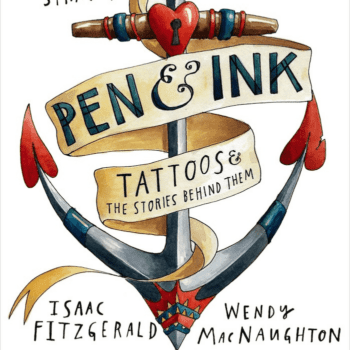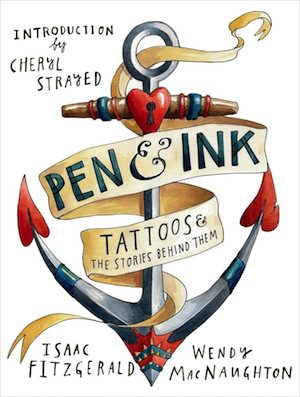
“We are our stories and tattoos are how we remember to never forget”—Isaac Fitzgerald
I was twenty-five when I got my first tattoo. As with most of the decisions I make, I spent much time agonizing over what the tattoo should be. Your first tattoo needs to be meaningful, or so people insisted on telling me. Tattoos are permanent, they said, as if I need reminding. Why would I even want a tattoo?
My mother pointed out that tattoos graced the likes of sailors, criminals, and members of biker gangs, not people like me. After all, I was the quintessential good girl: the kind of rule-following, cute-but-not-pretty overachiever that moms everywhere want their daughters to be. At least, that’s what my mom wanted me to be, and this was what everyone assumed I was.
I decided on a small dove. I was testing out liberal Christianity at the time, and the dove seemed to fit with my newest attempt at religion. Doves also symbolized peace. Look, my choice seemed to say, this is the tattoo of a good girl. What it also whispered was, Please don’t be disappointed in me.
The tattoo artist, Mark, seemed bored with the subject matter, but he sketched a few different doves to give me choices. I remember being more fascinated with Mark than my possible tattoo designs. He was covered in tattoos. I could barely glimpse un-inked skin, except for his pierced face. Later, after he gave me several tattoos and we became tentative friends, I asked him what his tattoos meant. He never answered.
His sketches were pretty straightforward. There was a dove that looked like the dove you see on countless evangelical Christians’ wrists and ankles: no. There was a more abstract version with sharp angles: nope. Then there was a dove that yearned to be Disney, that evoked animation with cute, curvy lines. If Snow White got inked, I thought, she would pick this dove. I fell in love with it. In the moment, I didn’t care what the Disney dove represented or what others might think. I just knew I needed this tattoo. I flinched at the buzzing sound of the tattoo gun and the initial pain of the needles penetrating my skin. After about fifteen minutes, I had my first ink. I immediately craved more.
That was nine years ago. Now I often forget about the little dove when someone asks me how many tattoos I have. But that dove marks a moment in which I decided to become someone no one expected me to be. The act of getting tattooed was more radical than the design I picked. I endured the bewilderment and chagrin of my parents, friends, and academic colleagues. I didn’t look like the type who wanted tattoos, they noted gravely. My first tattoo was a claim I made about myself. I wanted to be a person who bucked expectations. I wanted to be a person with tattoos.
My small act of rebellion grew larger as time passed. I was so very tired of being judged and dismissed. The more others pressed their expectations upon me, the more I turned to tattooing to protest. My first led to my second (a unicorn on my back), third (a Leo sign on my wrist), fourth (hummingbird, bee, and flowers that cover most of my right calf), fifth (stars on both forearms), sixth (finch on my left foot), seventh (a three-quarter sleeve on my left arm with hazy water, three multi-colored goldfish, a poison dart frog, and lily pads in bloom), eighth (a heart with wings near my shoulder), and ninth (notebooks turning into birds flying up my right arm). I’ve spent more hours underneath a tattoo gun than I care to add up. I still flinch every time I hear the buzzing of the tattoo gun. My body knows that sound means pain, but it also sounds like liberation.
Ink became a way to tell my story, separate from expectations and dismissals. It was a declaration of self, etched lovingly into skin.
This is why Isaac Fitzgerald and Wendy MacNaughton’s Pen & Ink: Tattoos & The Stories Behind Them—a collection of personal essays about the contributors’ tattoos, adorned with striking illustrations by MacNaughton—is the perfect book for me. I’m reminded that we all struggle with our stories and sometimes we need more than words to tell them. Tattoo by tattoo, the contributors share their stories and so much more.
Contributors speak about heartbreak, loss, disquiet, death, bravery, family, love, friendship, ambivalence, humor, and pain in a way that feels simultaneously unique and universal. Ink mingles with blood. Stories are told. Tattoos and the words we use to describe them reveal both too much and too little. Fragments of lives appear on skin. Tattoos emerge as claims about who we are and who we want to be, what we hope to remember and what we hope to forget, what creates us and what destroys us. Sometimes hurt needs to be visible and permanent if we are ever going to recover.
It is easy to forget that tattoos are scars. The buzzing tattoo gun contains sharp needles that bury the ink in the skin. Your body, then, attacks the ink because it is a foreign invader. Eventually your immune system wraps it up, and the ink becomes cloaked in you. This scar becomes a piece of you, but the process of tattooing can also leave behind remnants beyond ink. Some of my tattoo artists were kinder on the flesh than others. Underneath the tattoo on my calf I can feel the grooves left behind by a heavy-handed tattooist. A teal hummingbird hides the scars, but a simple touch reminds me that they are still there. Tattoos are strangely public and intimate. You can see the images, but the meaning can be hidden and elusive. We need to talk about them as a way to bear witness to our stories.
My body is a collection of scars just like anybody else’s, but tattoos are the only scars I’ve chosen. Skin bears the brunt of experiences. Keloid scars rest on both of my shoulders. Cesarean scars lay on top of one another. My right cheek has a dent from a stray punch that emerges only when I smile. Other scars, those emotional ones that never quite seem to heal, lurk beneath the surface. Scars and wounds, bumps and scratches, lumps and bruises, ink and no ink. Our bodies are the cartographies of our lives, and MacNaughton draws maps of the contributors’ tattoos.
Good stories are never just about one thing. My first tattoo was my initial attempt at crafting my story, but it was about more than rebellion. It coincided with my early PhD research on white supremacists. Every day I would read scholarship about hate, page through archival documents about the Klan, and analyze rhetoric and violent actions. I spent most of my waking hours with evidence of how terrible people can be. While researching and writing about hate, I got a Disney dove tattooed on the inside of my left leg. I scarred myself to remember peace. I needed hope and optimism, so I embedded them within myself.
 In the pages of Pen & Ink, I found people like me, who turned to tattooing to make sense of the world we live in and tell their stories. To say I loved Pen & Ink feels like an understatement. The essays got under my skin. I dwelled with the embodied nature of storytelling. I thought carefully about the subversive power of body modification. Fitzgerald reminds us that every tattoo tells a story, and every design communicates a vision of a life in a particular moment. We are crafting our bodies into stories.
In the pages of Pen & Ink, I found people like me, who turned to tattooing to make sense of the world we live in and tell their stories. To say I loved Pen & Ink feels like an understatement. The essays got under my skin. I dwelled with the embodied nature of storytelling. I thought carefully about the subversive power of body modification. Fitzgerald reminds us that every tattoo tells a story, and every design communicates a vision of a life in a particular moment. We are crafting our bodies into stories.
The contributors offer up tattoos and stories for readers, and we can share in their joy, pain, and humor. There’s an honesty and vulnerability about the essays and images that is staggering. I wish I could be so honest. I want to be honest with you about me and my tattoos, but that requires a vulnerability that I just can’t manage. While I might lull you with general stories of rebellion and identity, I’ve been mostly evasive about what my tattoos mean. I document what images adorn my body, but I don’t connect scars and stories neatly. This is on purpose. Stories are not often neat.
As I write, I’m planning my tenth and eleventh tattoos. Instead of beloved images, I want words etched onto arms and wrists. I need reminders of the life I want to lead. Images don’t carry the sting, the urgency, of words. I need to narrate the story I want to become. If it is carved into my flesh I must do what is written. At least I hope so. Rebellion no longer resonates like it once did.
I’m not the only one who has changed. My mother now admires my ink. She actively defends tattooing. I’m not sure what this means. It is just ink on skin, she tells me now. I want to tell her that tattoos, mine or anyone else’s, are so much more. I reside in the images etched into my skin. When she defends tattoos, she defends me. But I never tell her that. It feels too intimate. Instead I parrot her words, just ink on skin, and listen to her admire what I’ve etched.





